If you live in a house with windows facing west, north or east, you should select flowering plants especially carefully. Most flowers love light, but this is not a reason to abandon your home flower garden.
Photos of shade-loving blooming indoor flowers
Caring for all types of flowering plants involves timely watering and removing faded flowers. In addition, flowering flowerpots should be protected from drafts and sudden temperature changes. During the cold season, do not leave them on windowsills. If there is little light in the apartment, choose those plants that tolerate darkened rooms and do not like direct sunlight. Here is the list in alphabetical order:
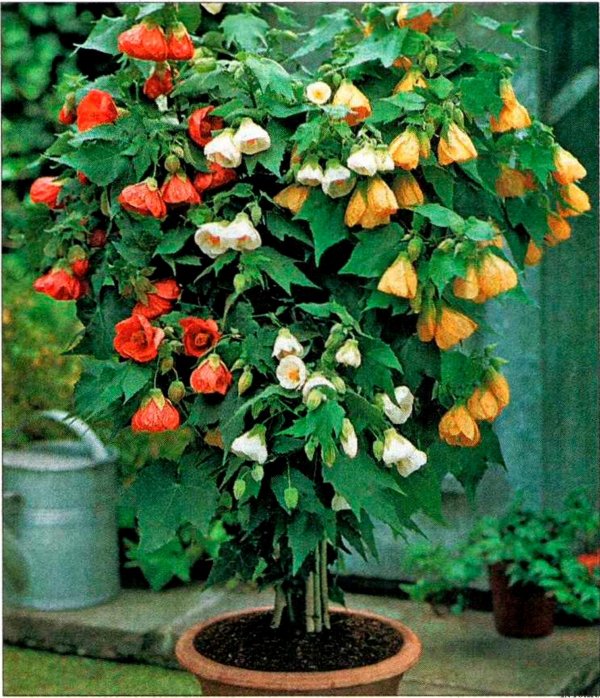
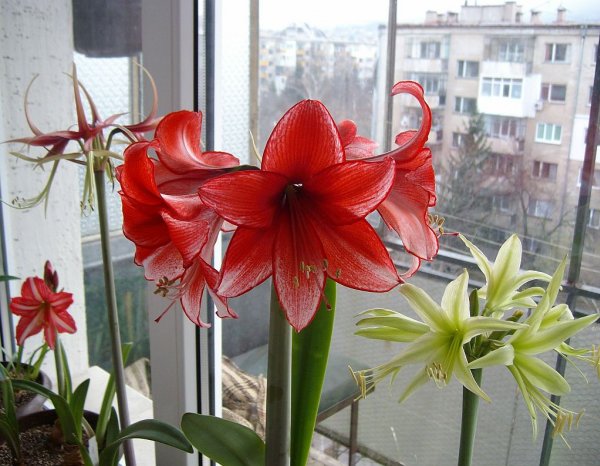
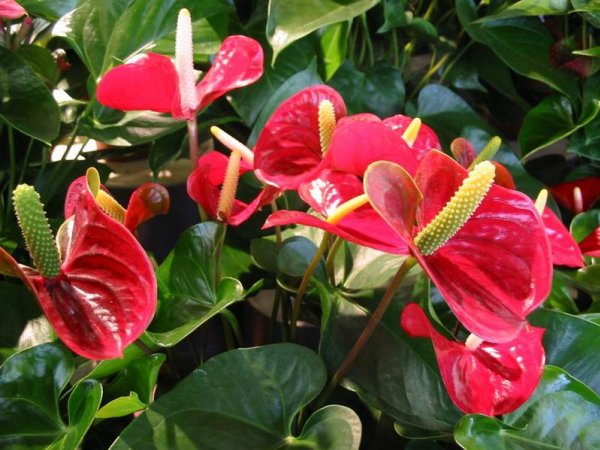
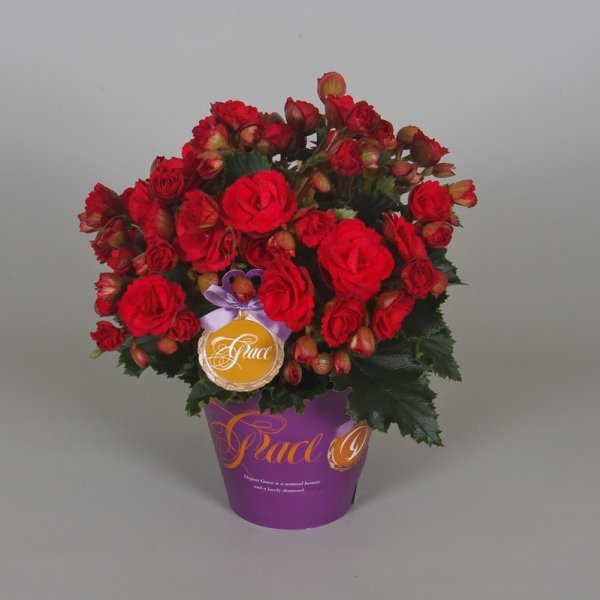
![]()
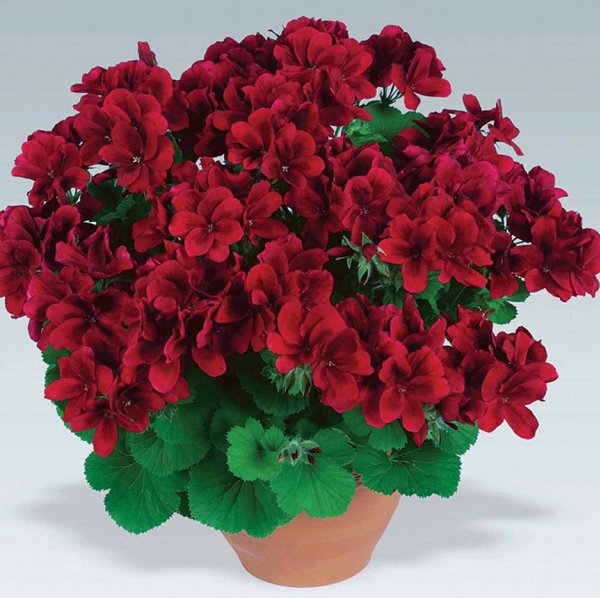

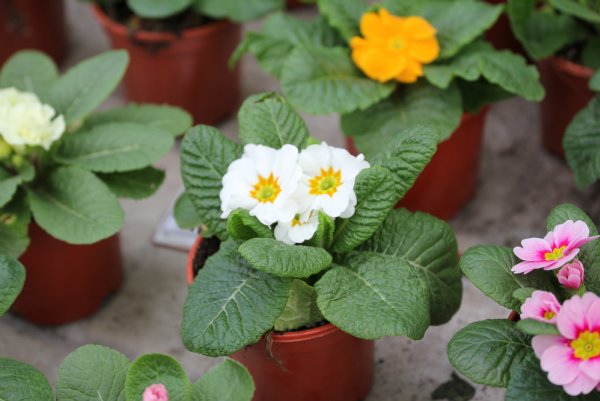
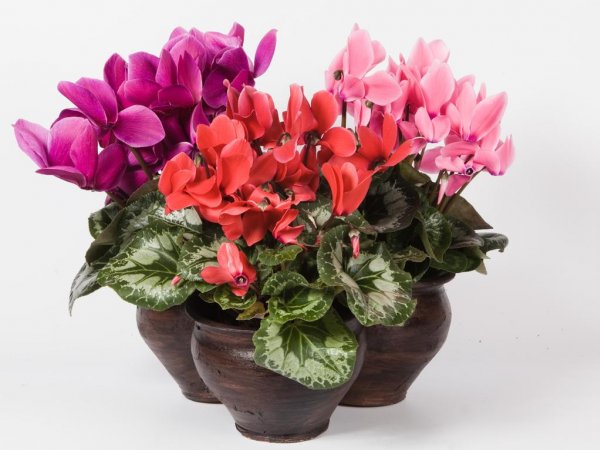
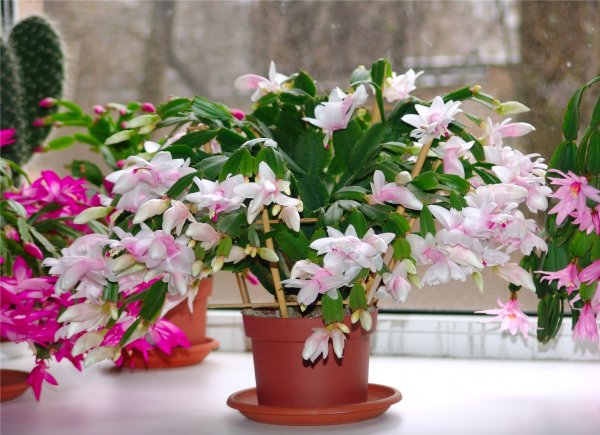
Photo of unpretentious indoor climbing indoor flowers
Various kinds of climbing plants are so popular because they are easy to care for and produce abundant greenery. Both local ivies and exotic vines grow quite quickly, and some even enjoy rare but beautiful periods of flowering. All these plants need is regular but not frequent watering and timely replanting. However, they are replanted no more than once a year, or even twice.
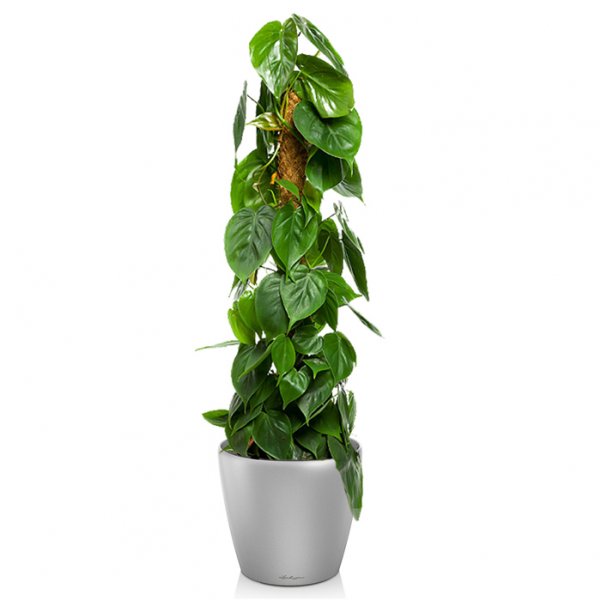
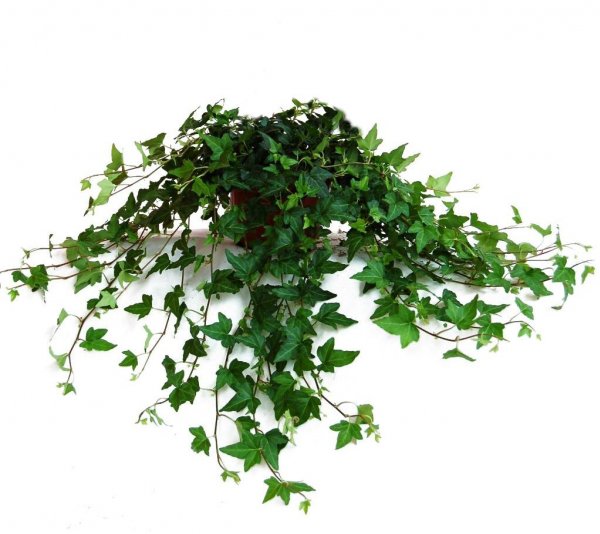
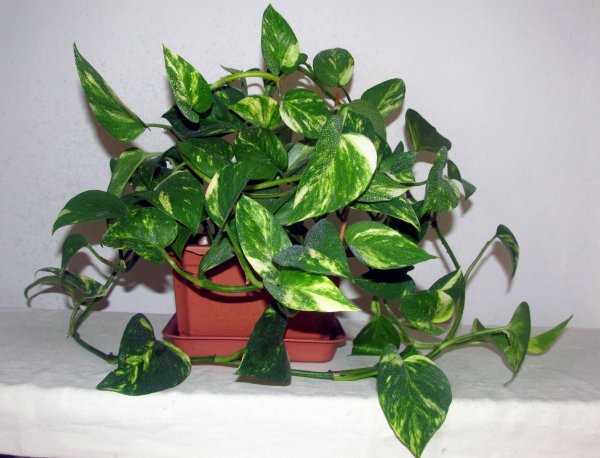

Photo of beautiful indoor flowers with red leaves
This amazingly beautiful plant has many names: beautiful euphorbia, poinsettia. But in everyday life it is most often called the Christmas star or simply the Christmas star. It owes its name to the fact that on winter days it serves as an invariable decoration of any interior, thanks to the bright red color of the leaves.
In the USA, on the eve of the Christmas holidays, about 40-50 million poinsettia flowerpots are purchased. But for all its beauty, the plant is not too whimsical: good lighting, a temperature not lower than 14-16 ° C and moderate watering - that’s all that is required for normal development plants.
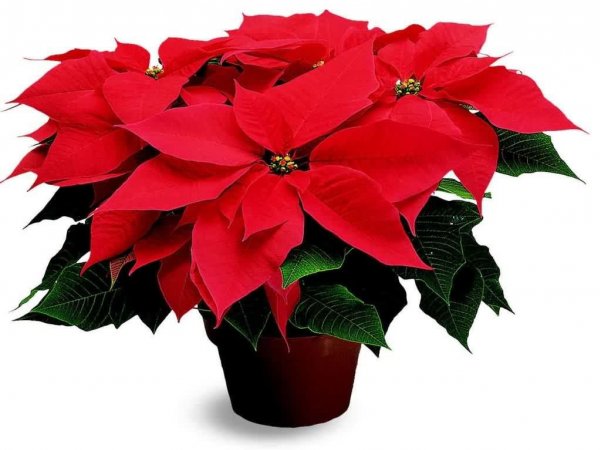
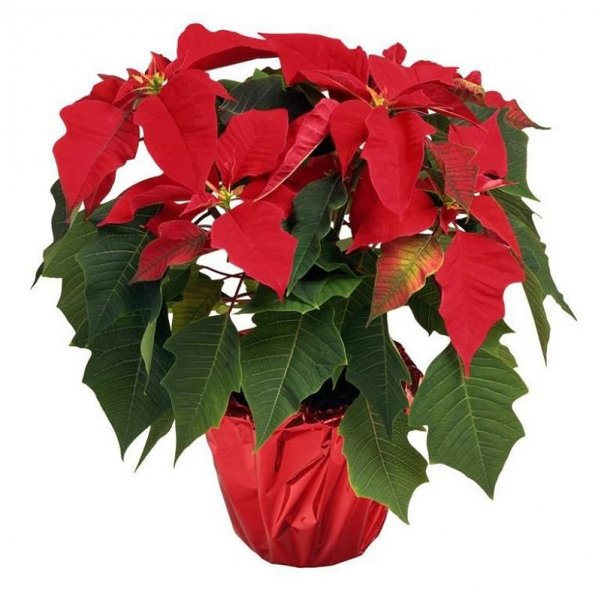
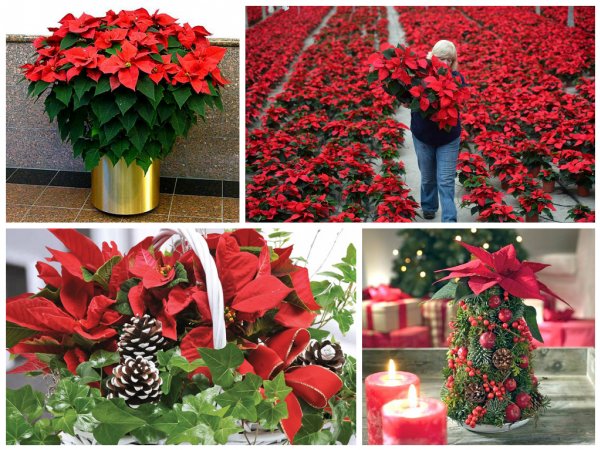
Photo of large non-blooming indoor flowers
Non-flowering houseplants are unpretentious and are perfect for those who suffer from pollen allergies. They require basic care and create a good microclimate in the room.
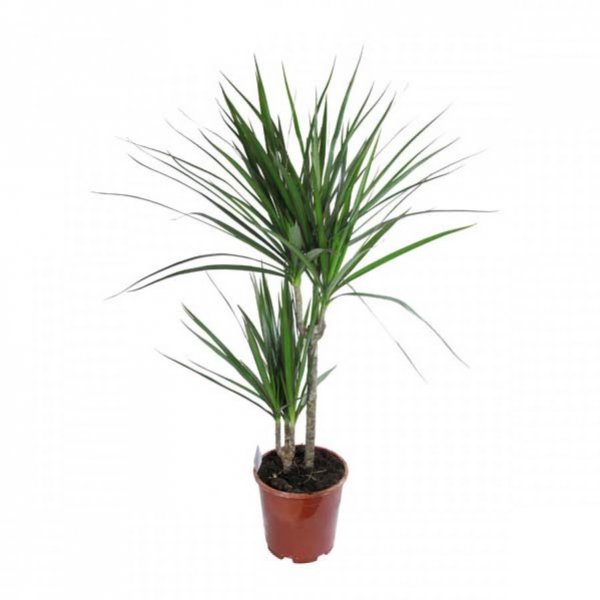
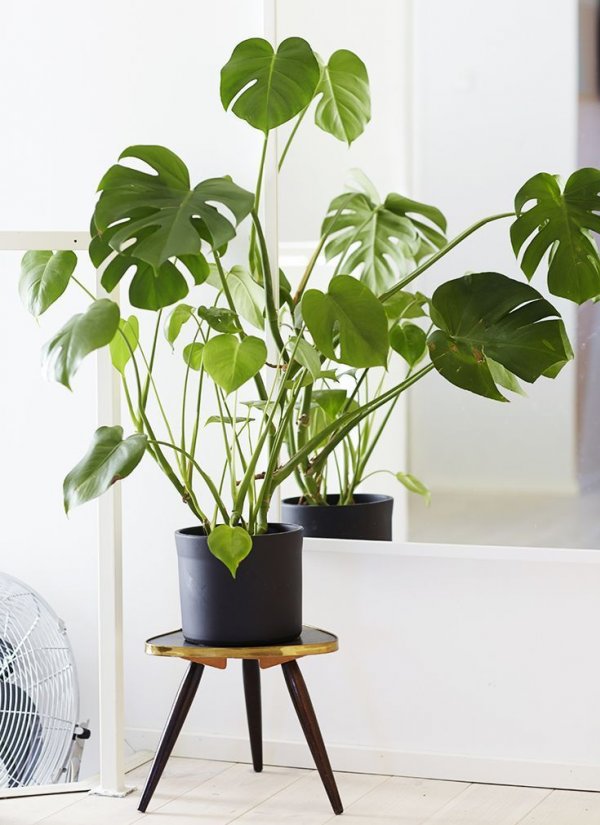
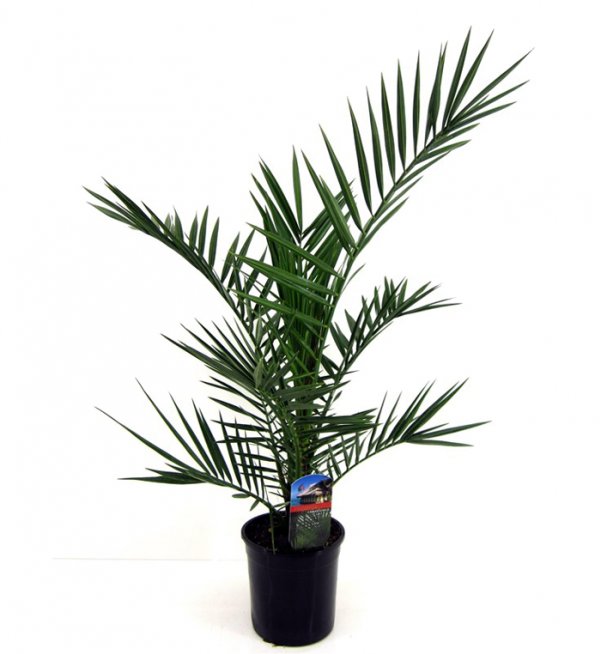
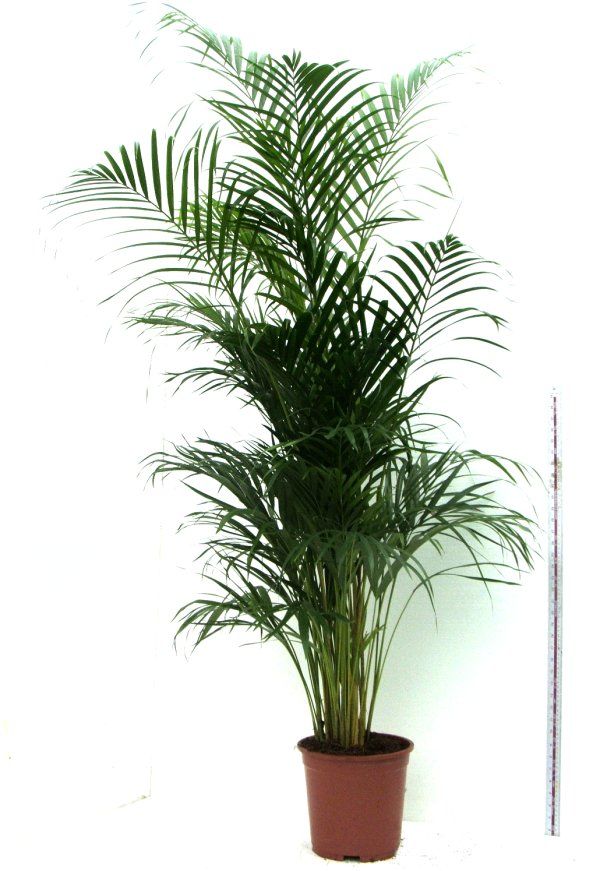
Photos of the most beautiful exotic flowers
The more flowers appear in stores and markets, the more we want to acquire something original and exotic. But exoticism does not always require special care, often such flowers and plants are imported from places with a rather harsh climate and they grow well in apartments and houses.
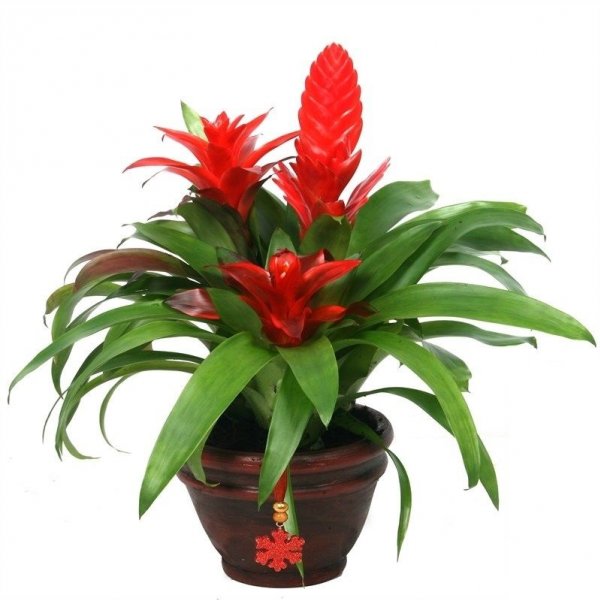
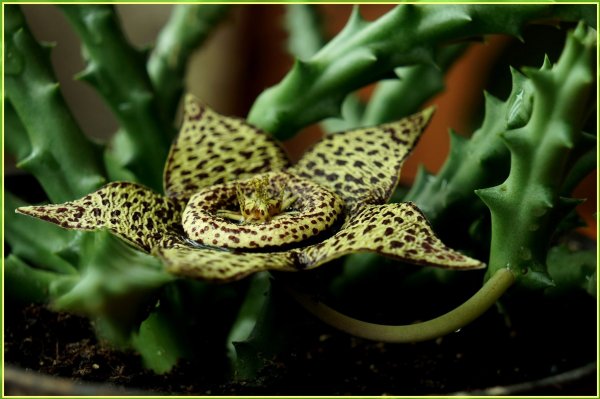
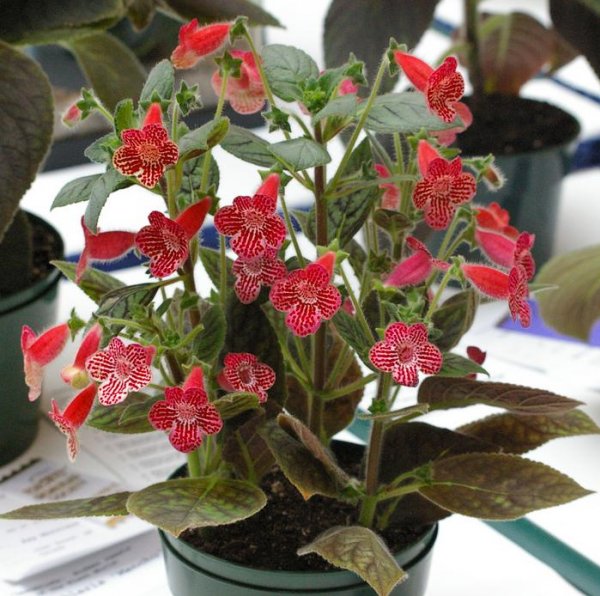
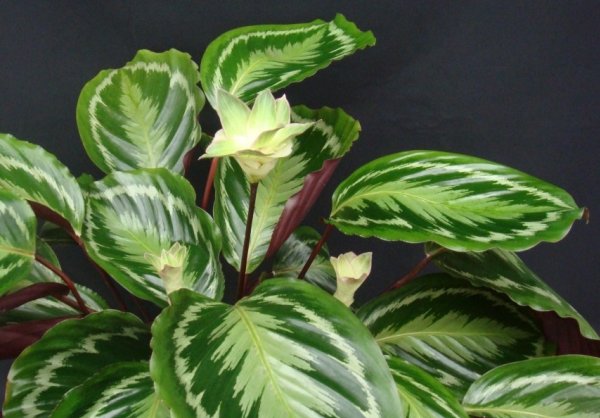
Photos of hanging flowers
Ampelous plants are distinguished by long, flexible shoots that creep along the ground. As a rule, they have flowing shoots, which is why they are mainly planted in flowerpots, where they look especially impressive. Annual fast-growing hanging flowers are extremely popular and are used for landscaping balconies and terraces.
Among the hanging ones there are different types plants: flowering, decorative deciduous, semi-shrub forms, succulents and herbaceous species. There are hundreds of types of hanging flowers, to which more than one catalog is dedicated, but we have chosen the most affordable and spectacular ones.
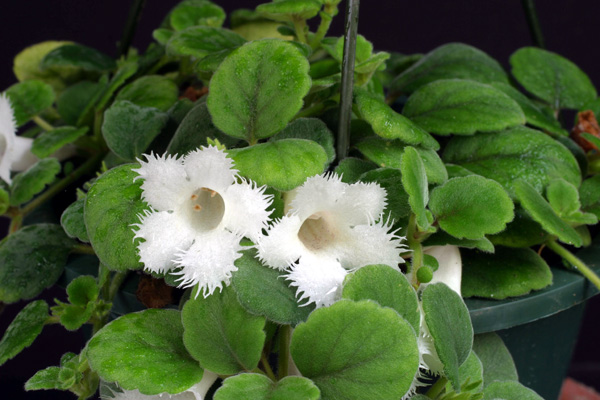
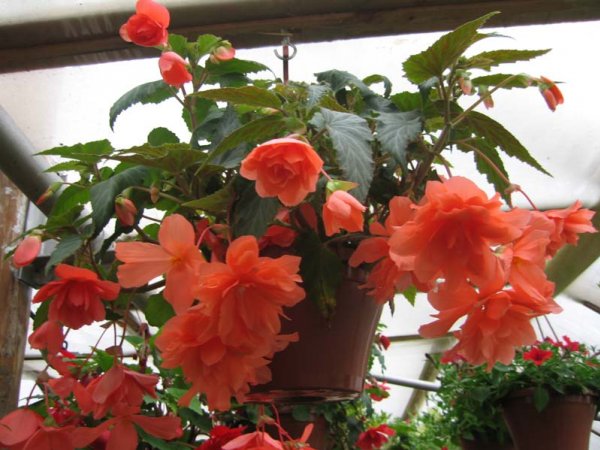
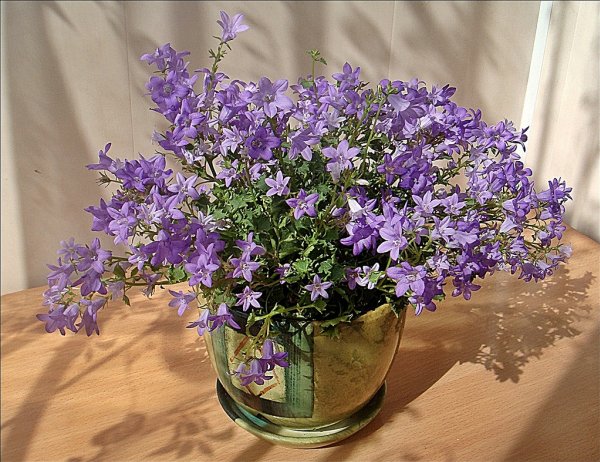
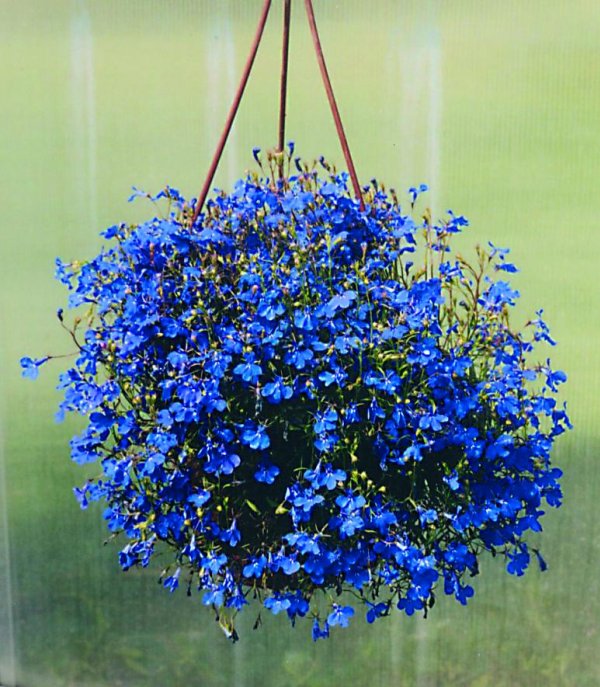
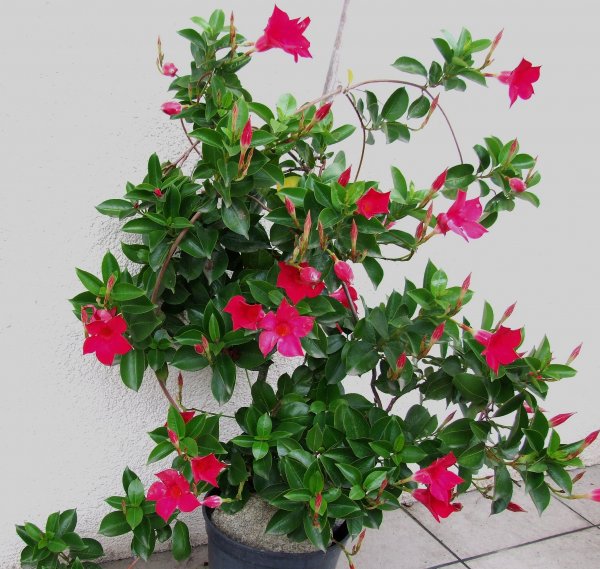
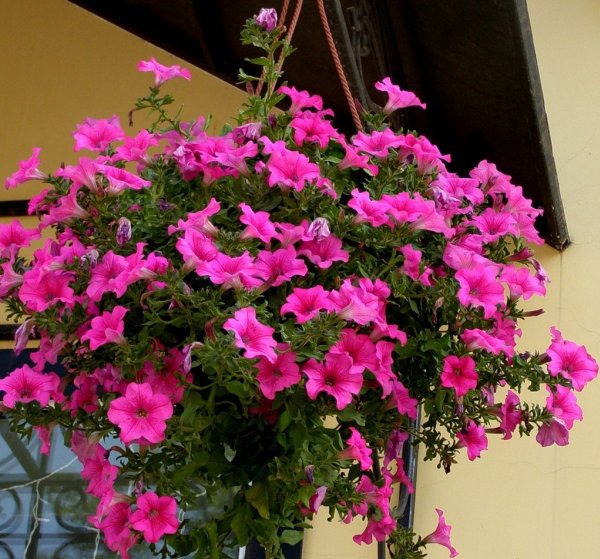
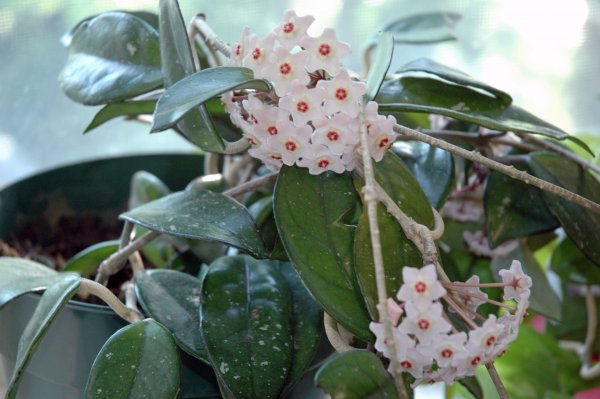

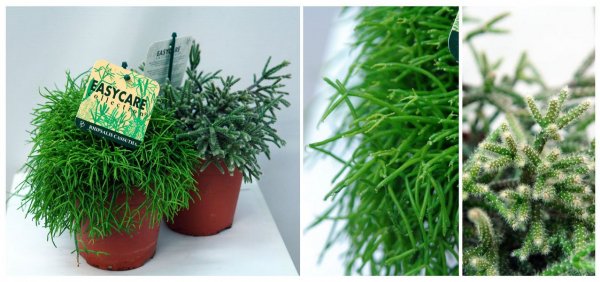
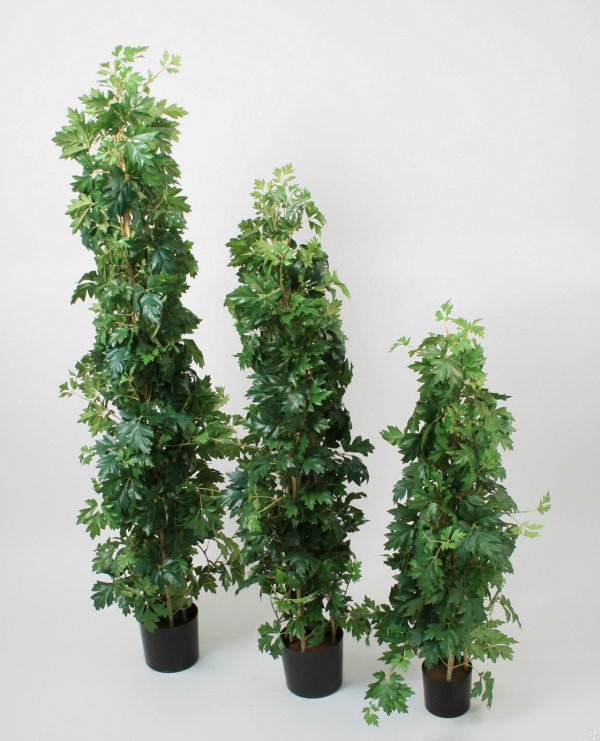
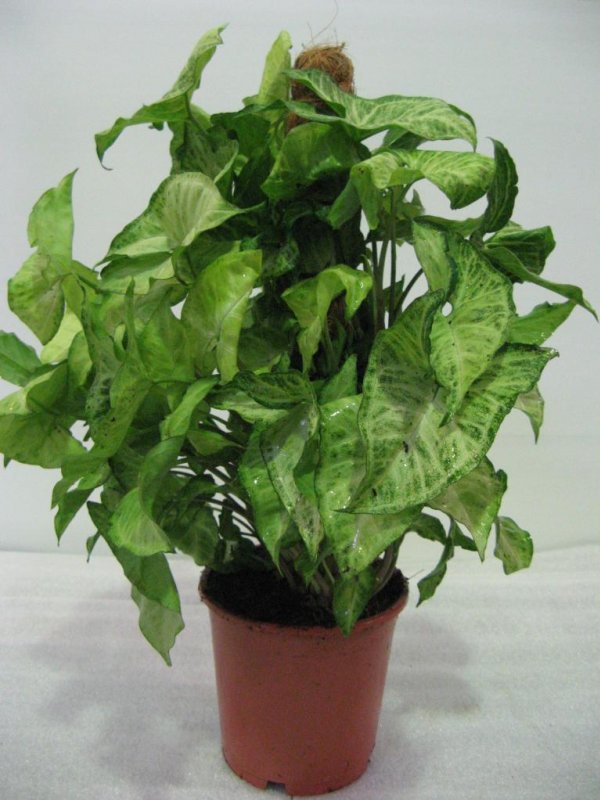
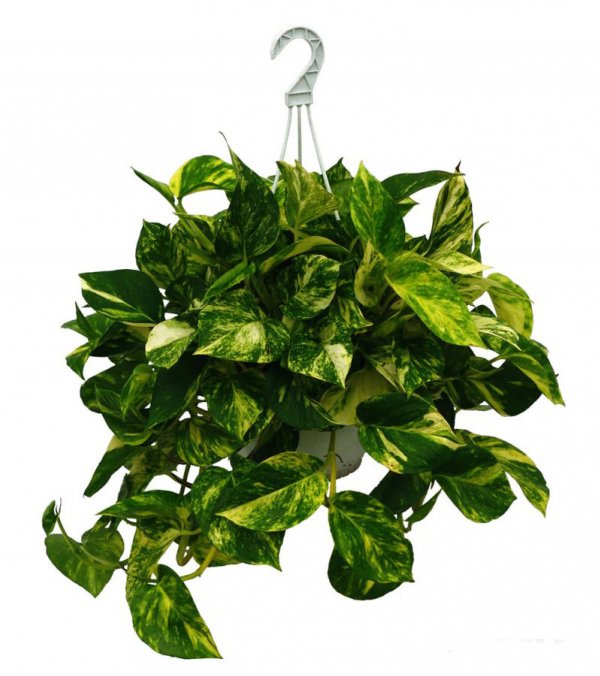
You looked at a selection of photos of indoor plants. Big photo can be seen in the section
Red color is a symbol of passion. That is why red flowers are preferred in the bedroom. However, this does not mean that they are strictly prohibited from entering other rooms. Homemade red flowers will perfectly set off the pink abundance on the windowsill in the living room, become a bright spot in the office, and, of course, will delight the little ones in the children's room.
The most striking representatives of this group of plants are gerbera, hibiscus, olendra, pentas, pomegranate, wallot, leea and, of course, spurge. Here you can read a description of indoor flowers with red flowers, learn about caring for them and their propagation.
Below is a description of red flowers showing their photos.
Red indoor gerbera flowers
Gerber Jameson(Gerbera jamesonii) blooms from May to August. Its varieties have simple and double inflorescences. The color of the inflorescences can be yellow, orange, red, pink and white with a central yellow disc. However, the most popular are red indoor gerbera flowers. Their flower stalks can reach a height of 60 cm, which does not look very beautiful; More compact varieties have appeared not so long ago.
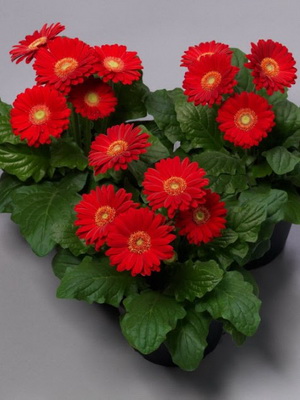
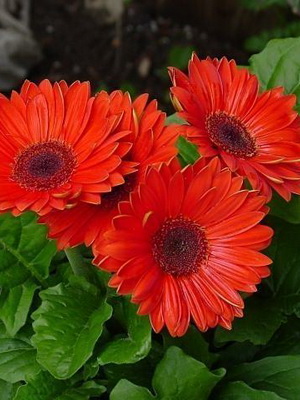
Gerber Jameson(Gerbera jamesonii) Happipot is a compact variety - flower stalks reach a height of 25-30 cm. When grown from seeds at home, a number of tall-stemmed plants are obtained; For this, it is better to choose the more uniform Parade variety.
Temperature: Moderate - 10-21°C.
Light: Bright light with some sunlight.
Watering: Keep the soil moist at all times.
Air humidity:
Care after flowering: Plants are not preserved or placed in a greenhouse.
Reproduction: Sowing seeds in spring.
Hibiscus: indoor flower with red flowers
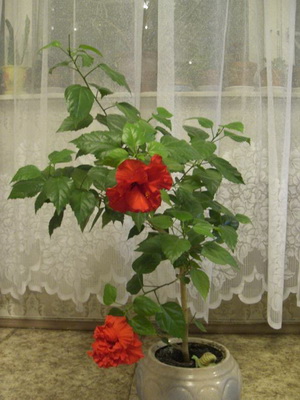
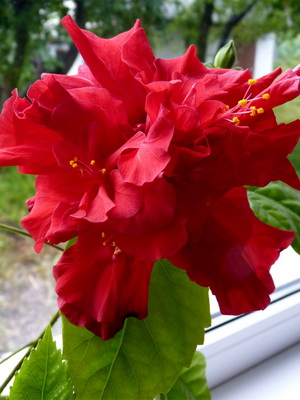
(HIBISCUS)- a spectacular flowering plant for sunny windowsill. Large flowers short-lived, but appear from spring to autumn. This red-flowered indoor plant requires regular pruning - trim the stems in late winter to encourage tillering. An unpruned hibiscus bush can reach 1.5 m or more. It can be given a standard shape.
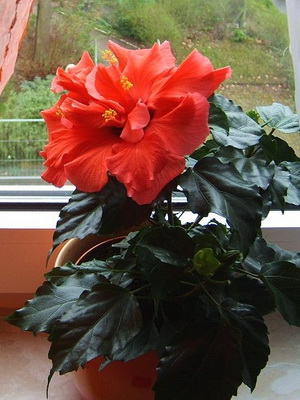
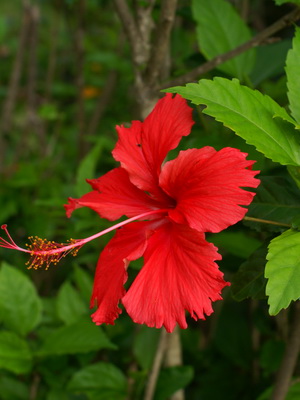
Chinese hibiscus(Hibiscus rosa-sinensis)- main view; Numerous varieties have flowers that are white, yellow, orange, pink or red. The Cooperi variety has variegated foliage.
Temperature: Moderate - minimum 13°C in winter.
Light: As much light as possible. Protect from direct sunlight.
Watering: Keep the soil moist at all times. In winter, reduce watering.
Air humidity: Spray the foliage from time to time.
Transfer:
Reproduction: Stem cuttings in spring.
Red indoor flower olenadra and its photo
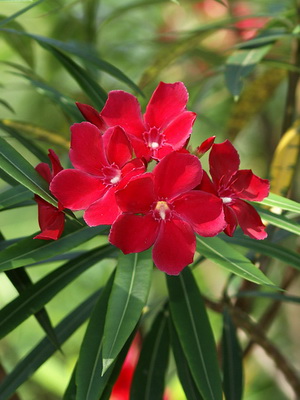
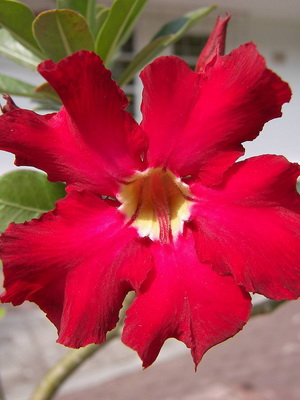
Oleander is grown in a large room or winter garden. In summer, fragrant flowers appear in inflorescences. It is not easy to care for an oleander when it grows - the pot has to be moved to an unheated room for the winter, and to the garden for the summer. In autumn, the shoots that bloomed are pruned. Oleander wood and sap are poisonous. Oleander leaves often resemble willow leaves.
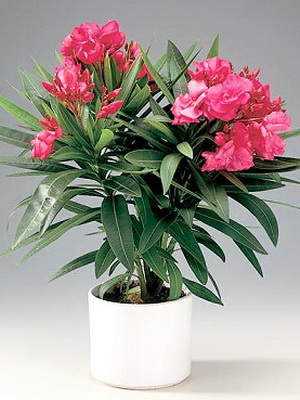
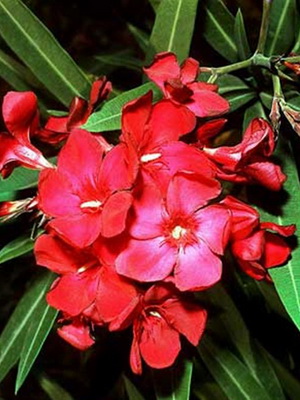
Common oleander(Nerium oleander) can look compact in a garden center. However, as you can see in the photo above, this red indoor flower with age can turn into a spreading bush about 2 m tall. There are varieties with white, pink, red and yellow flowers.
Temperature: Moderate - minimum 7°C in winter.
Light: Choose the brightest place you can find.
Watering: Water deeply from spring to fall. Water sparingly in winter. Use lukewarm water.
Air humidity: Do not spray foliage.
Transfer:
Reproduction: Stem cuttings in spring or summer.
Home flowers with red pentas flowers
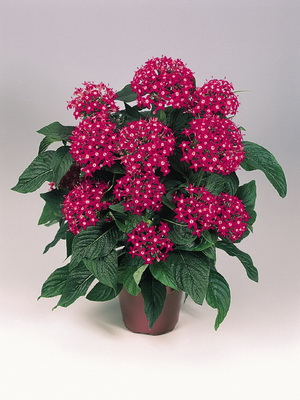
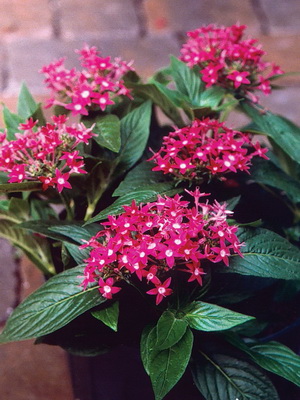
Pentas(PENTAS) grown in a sunny window. The tips of the shoots need to be pinched regularly so that the bush does not become leggy. Maintain a plant height of about 45 cm. These red-flowered house flowers bloom irregularly - buds will appear at any time of the year, and most usual time- winter. Pentas are easy to grow.
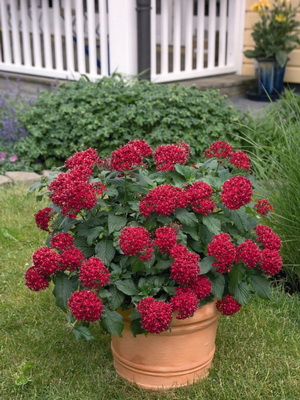
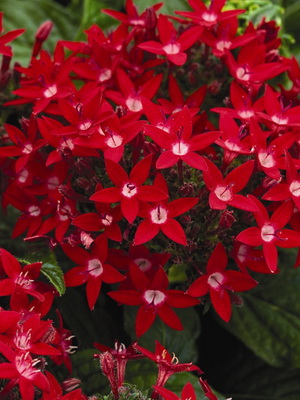
Pentas lanceolate , or meat red(Pentas lanceolata, or P. carnea)- main view. The inflorescence consists of numerous tubular, star-shaped flowers; There are white, pink, red and mauve varieties.
Temperature: Moderate - minimum 10°C in winter.
Light:
Watering: Keep the soil moist at all times - reduce watering in winter.
Air humidity: Spray the foliage from time to time.
Transfer: Replant annually in the spring.
Reproduction: Stem cuttings in the spring - use hormones for rooting.
Pomegranate: a houseplant that has red flowers
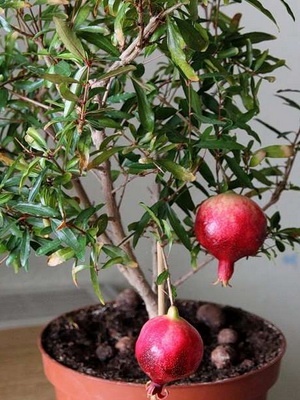
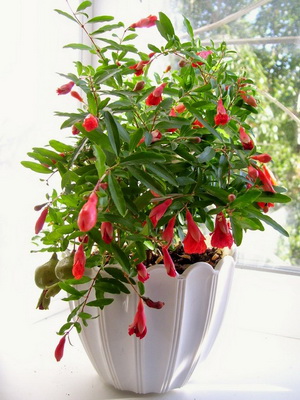
An ordinary pomegranate (PUNICA) is not suitable for a living room, but a dwarf indoor plant with red flowers is an excellent option for a sunny window. The flowers may give way to bright orange fruits, but they will not ripen. In summer the pot can be placed outdoors, but in winter it requires a cool place. During the dormant period, the leaves fall off.
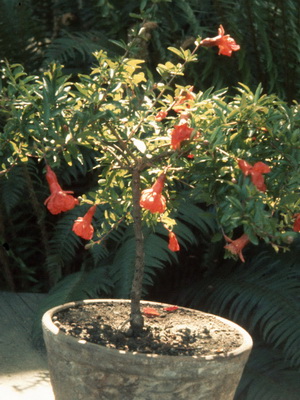
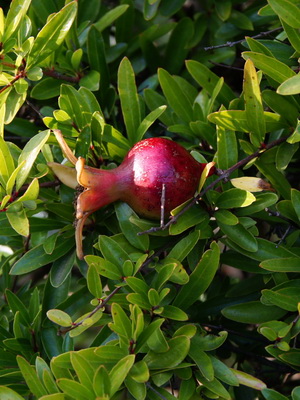
Dwarf form common pomegranate(Punica granatum nana) grows up to 1 m tall. It has glossy leaves and bright colors appear in summer. scarlet flowers. Ball-shaped fruits will form if you are lucky.
Temperature: Moderate - minimum 4°C in winter.
Light: Bright light - some direct sunlight is necessary.
Watering: Water deeply from spring to fall. Water very sparingly in winter.
Air humidity: Spray the foliage from time to time in the summer.
Transfer: Replant if necessary in spring.
Reproduction: Stem cuttings in summer. Use rooting hormones and heating the substrate.
Indoor red wallot flowers and their photos
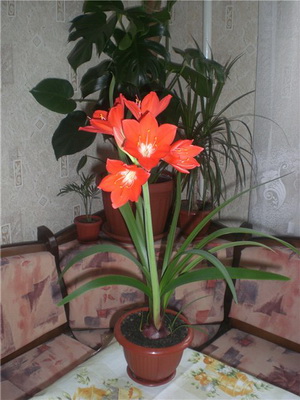

In spring, plant the bulb tightly in a 12cm pot, leaving the top half uncovered. Keep VALLOTA in a cool place in winter, remove spent flowers and leaves, and let the soil dry out slightly between waterings. At the end of summer, umbrellas of flowers appear. Don't repot it until the cluster of bulbs begins to overwhelm the pot.
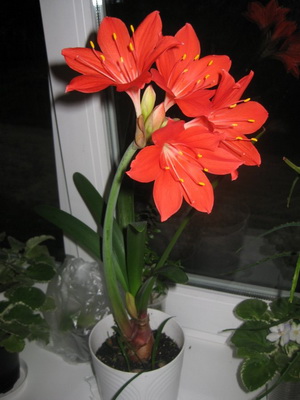
![]()
Vallota is beautiful(Vallota speciosa) Suitable for a sunny windowsill. As you can see in the photo above, these red indoor flowers have evergreen leaves and peduncles 30-60 cm high. There are varieties with white and salmon flowers.
Temperature: Moderate - minimum 10-13°C in winter.
Light: Bright light with some direct sunlight.
Watering: Water thoroughly when the substrate begins to dry out. Water sparingly in winter.
Air humidity: Wipe the leaves with a damp sponge from time to time.
Transfer: Replant in the spring every three to four years.
Reproduction: Dividing plants during transplantation or separating offspring from an adult plant and planting them in the summer.
Houseplant with red leea flowers
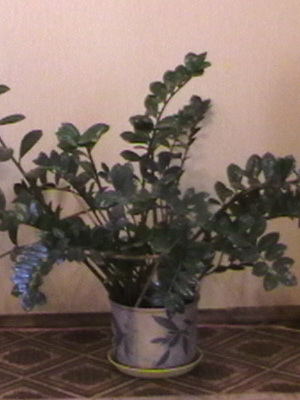
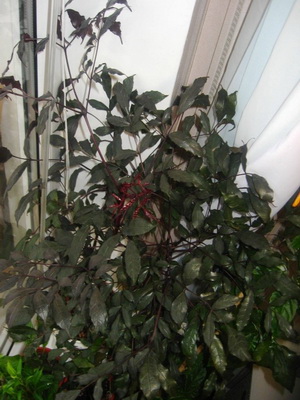
Leea(LEEA)- a shrubby plant with large leaves, each of which is divided into many pointed leaves. The foliage is bronze-red in color at a young age, but tends to turn green when ripe. This houseplant with red flowers needs to be fed regularly during the growing season and kept away from drafts. Can be used as a single plant in place of Fatsia japonica.
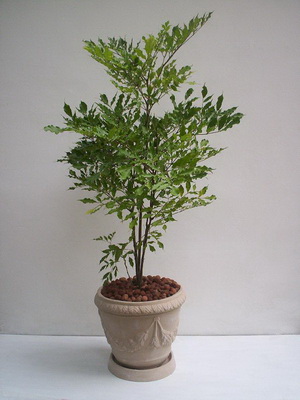
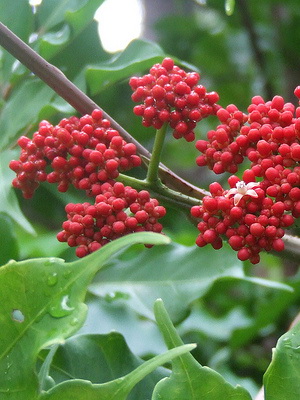
How to grow a houseplant one variety - leeya bright red(Leea coccinea); sometimes it is sold under the name L. guineensis.
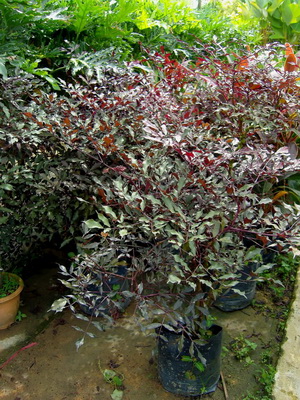
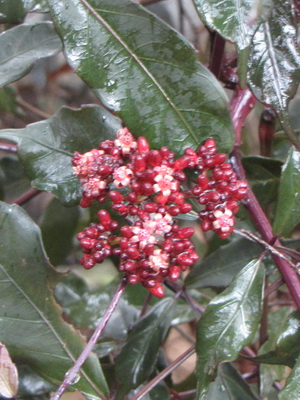
The Burgundy variety retains its red foliage in good light.
Temperature: Moderate - if possible, keep in a cool place in winter.
“Angel wings” is what one would like to call luxurious leaves indoor plant caladium. The large leaves of caladium are heart-shaped or spear-shaped; they are amazingly beautiful due to their bright colors and beautiful pattern. The leaves grow on thin petioles and seem to flutter in the air. Caladium can be called one of the brightest indoor plants from the decorative foliage group.
Caladium - tuberous plant , the genus includes up to 15 species of herbaceous plants and belongs to the araceae family. In culture, hybrid forms of plants are mainly used, obtained by crossing several natural species; they have a common name garden caladium (Caladiumhortulanum) or caladium bicolor (Caladiumbicolor).
04 Oct 2013
Euphorbias have gained a popular place among indoor plants due to their unpretentiousness and unusual appearance. Different types Euphorbias are so different from each other that you can’t even tell that they are related plants from the same euphorbia family (Euphorbiaceae). Even by appearance it is difficult to determine whether it is a shrub, a cactus or a herbaceous plant that is not at all related to succulent plants.
Euphorbia brilliant or Euphorbia Mila (E.Milli) is a prominent representative of this family, known in indoor floriculture as an unpretentious flowering plant in the form of a thorny bush. This plant is also called the “crown of thorns”; its curved stems look quite menacing, as they are covered with sharp long spines.
30 Sep 2013
Among the varieties of indoor ficuses there are not only large plants in the form of trees, but also beautiful view ampel-shaped ficus - ficus dwarf or tiny(Ficus Pumila). This is a ground cover plant with thin long shoots that spread along the surface of the ground or climb tree trunks, clinging with aerial roots. The greenery of the ficus covers the surface like moss; the plant has surprisingly small leaves, 2-3 cm long, heart-shaped. The surface of the leaves is characteristic with bubbly swellings between the veins.
Dwarf ficus comes in two varieties with relatively large leaves 2-3 cm (macrophylla) and with tiny leaves up to 0.7 cm long (minima). The variegated varieties of dwarf ficus with a cream or white border along the edge of the leaves are very beautiful.
21 Sep 2013
Agave - spectacular succulent plant with large fleshy leaves collected in a rosette. Agaves grow in hot desert and tropical regions of South America. For residents of Mexico, agave is a source of water in desert areas, and its juice is used to make the famous alcoholic drink - tequila.
In total, the Agave genus unites about 300 species of succulent plants, of which only 50 species are grown in cultivation. Agaves of only dwarf forms are grown indoors or while the plants are still young and have not reached large sizes. In greenhouses, winter gardens and in countries with warm climates, agaves are grown in flower beds as a large ornamental plant.
14 Sep 2013
Scheffler decorative indoor shrub plant with beautiful leathery, glossy leaves. Schefflera leaves are complex - from 4 to 12 oblong leaves grow on a long petiole; they look like open umbrellas, stretching upward on thin petioles - knitting needles.
The genus Schefflera (Schefllera) includes about 150 species of evergreen shrub and tree plants growing in Southeast Asia, Japan, Island. Thailand and on the coasts of Australia. Only a few species of plants from this genus are used as indoor plants.
Schefflera arborescens(Schefllera) is a shrubby plant that grows to a fairly large size over time and can reach a height of two meters in indoor conditions. There are several varieties of Schefflera of this species, differing in the shape and color of the leaves.
22 Aug 2013
Hymenocallis for their graceful snow-white flowers they are often called “bride’s basket”, “Angel’s trumpets” or Peruvian narcissus, in fact the name Hymenocallis comes from the Greek words “hymen” - film and “callos” - beauty, the fact is that the hymenocallis flower has long stamens grow together with a funnel-shaped film, forming a crown like a daffodil. The flower is given a special airiness by six long narrow petals hanging down.
The flowers are collected in an umbellate inflorescence at the top of a long (up to 80 cm) tubular peduncle. The larger the bulb, the more flowers are produced in the inflorescence, usually from 7 to 15 flowers in an inflorescence. Plants bloom depending on the species, some in spring or early summer, others in mid-summer or closer to autumn.
14 Aug 2013
Hot Mexican pepper has a Latin name - Capsicum (capsicum). This one is very hot capsicum is a very popular spice and seasoning for adding fiery heat to dishes. Many housewives grow hot peppers not only in the garden beds, but also on the windowsill at home. Capsicum peppers are often grown to decorate the interior, since the plant is densely strewn with bright ripe fruits - miniature peppercorns - looks very attractive and elegant.
Nowadays there are a lot of seeds of various varieties of ornamental peppers on sale, different in shape and color of the fruit, plant size and requirements for living conditions. Some varieties of ornamental peppers are inedible, others differ in the degree of pungency and aroma.
24 Jul 2013
Oleander- a shrub plant attracts attention during flowering; delicate flowers bloom all summer, spreading a fragrant aroma. Oleander as an ornamental plant was grown in Ancient Greece, and the name from the Greek language means “oleo” - aroma, “Andros” - the name of a Greek island.
Common oleander(Nerium oleander) grows naturally in forests and river valleys of the Mediterranean (Greece, Italy, Spain). This is an evergreen shrub plant with highly branched shoots reaching a height of 4 meters, on which elongated, pointed leaves are arranged oppositely or in whorls of three. The leaves are leathery, dark green with a light vein prominent in the center. Flowers are collected in inflorescences - brushes. Now there is big choice varieties of oleander differing in the degree of doubleness of the flower from simple to strongly double; in color, oleander flowers are white, yellow, a large number of shades of pink to dark red, orange. Oleander flowers come in strong, weak and odorless varieties. The strong aroma of a flowering plant in an unventilated area can cause headaches.
21 Jun 2013
Coleus- a plant with brightly colored leaves, which is popularly called “colored nettle”. This decorative foliage plant grown as indoor and garden annuals. Thanks to the variegated leaves with a painted pattern in several colors from bright red, crimson, to yellow, cream with a green border, this plant looks very attractive, even exotically bright.
Coleus is called “nettle” because the leaves of this plant are shaped like nettle leaves, broadly oval, oppositely located on the stem, with a jagged edge and a velvety surface. The tetrahedral stem begins to branch strongly if you pinch its top.
"Sinningia speciosa".
Sinninginias belong to the Gesneriaceae family, like the well-known Saintpaulias (violets). There are more than 50 species of plants in the genus Sinninginia, of which, in addition to beautiful Sinninginia, Sinninginia broadleaf (S. Latifolia) is also used in indoor floriculture. Now flower shops offer a large assortment of gloxinia varieties under the general name gloxinia hybrid(Gloxinia hybrida). Varieties vary in flower color; in addition to simple flower shapes, there are also varieties with double flowers.
Calceolaria(Calceolaria) decorative flowering plant, which is grown both in the flowerbed and indoors as a potted crop. The genus Calceolaria belongs to the Norichaceae family and has more than 300 species of plants, among which there are annual and perennial species that are herbaceous, semi-shrub and shrubby plants. The name is given because of the original flowers; translated from Latin it means “slipper-like.” The flowers have an interesting shape - they are two-lipped, and upper lip small, and the lower one is swollen like a bubble. The color is very bright yellow, red, orange, sometimes with dark specks. Against the background of large soft green pubescent leaves, the flowers look even more expressive. Depending on the species, the leaves are oval or lanceolate, some deeply cut.
Calceolaria blooms very profusely, blooming more than 50 flowers at the same time; flowering indoors begins in the spring and lasts about a month; flowering in a flowerbed continues all summer.
20 but I 2012
Houseplant chlorophytum At first glance it may seem like an inconspicuous plant, however, it has several significant advantages. Chlorophytum grows quickly, soon forming a lush bush of openwork foliage that will look advantageous in any interior. It has also been established that chlorophytum perfectly purifies the air, releases phytoncides that destroy microbes and neutralizes harmful substances released by plastic and chipboards from which furniture is assembled. Therefore, by growing this indoor plant in your home, you will not only decorate the room with delicate greenery, but also improve the health of the air.
Chlorophytum belongs to the lily family. The genus includes about 220 species of perennial evergreen herbaceous plants with tuberous rhizomes. Mainly two species are grown indoors: crested chlorophytum (C. Comosum) and winged chlorophytum (C. Elatum).
18 but I 2012
Houseplant Kalanchoe(calanchoe) is decorative in all its appearance - it blooms beautifully and for a long time, and the original fleshy leaves seem to be cast from wax. Plants from the genus Kalanchoe are easily distinguished from other representatives of the Crassulaceae family by bright flowers. The genus includes about 200 plant species, which are very diverse from hanging to woody forms. These plants grow naturally in the tropics of South Africa, South Asia and South America. The homeland of most Kalanchoe species adapted for indoor growing is the island of Madagascar, where these plants usually bloom in January.
Kalanchoe are succulent plants, their leaves, depending on the type, are wide and fleshy or cylindrical in shape, accumulate moisture and nutrients, and if there is a lack of moisture during the dry period, the old leaves die, giving the accumulated reserves to new leaves.
12 but I 2012
As Christmas and New Year approaches, a wonderful indoor plant blooms - beautiful spurge or poinsettia(Poinsettia pulcherrima), there is also another beautiful name for this plant "Christmas Star". This perennial plant - deciduous shrub belongs to the genus Euphorbiaceae. In its homeland in Mexico, the shrub reaches a height of up to three meters.
In fact, the flowers of this plant are small and inconspicuous, collected in inflorescences on the tops of the shoots. But the bracts immediately attract attention - the bright red leaves around the flowers form a star pattern. Classic color bracts - red, but now there are varieties with white, cream, pink, bicolor and marbled varieties.
When buying blooming poinsettia in a store, choose a plant that has yellow-green flowers, then it will retain its bright decorative appearance for a long time.
10 but I 2012
Ficus- one of my favorites indoor plants. The genus Ficus (Ficus) includes many ornamental species, for example ficus benjamina, ficus lyreate, ficus rubbery, which will be discussed in this article and many others.
In nature, ficus trees grow in the tropical forests of Asia and Africa. Ficus rubbery(Ficus elastica) is an evergreen tree 20-30 meters high with aerial roots that serve as supports. In a room, this species can grow up to 3-4 meters in height. The dense leathery leaves, elliptical in shape, are very attractive and can reach a length of 20-30 cm. The leaf has a central vein. New leaves appear at the top of the shoot, opening from the shell. The leaves are attached to the trunk by short petioles.
08 but I 2012
Clerodendrum(Clerodenrum) beautiful flowering indoor plant, designed for bright, sunny rooms. The genus Clerodendrum belongs to the verbena family and includes about 400 species of evergreen or deciduous trees, shrubs and vines growing in the tropics and subtropics of Asia and Africa.
The most common species as a houseplant Thomson's clerodendrum(C. Thomsonae) is an ornamental flowering climbing shrub, distinguished by its magnificent bicolor flowers and compact shape. In nature, it grows in the form of a vine, up to 4 meters in height, climbing trees towards sunlight. As a houseplant, it is formed into a lush bush by pinching shoots or a support is installed for it and twisted around it during the growth period.
06 but I 2012
As houseplant clivia is attractive not only due to its bright flowers, its leaves are also quite striking. This plant was brought to Europe at the beginning of the 19th century from southern Africa. The genus is named after Duchess Charlotte Clivia and unites 4 species of plants from the amaryllis family. This perennial plant, under favorable conditions, can live up to 40 years, so in the Old and New Worlds it was passed on from generation to generation.
The most common type is indoor plant clivia cinnabar(Clivia miniata). This is a herbaceous, stemless plant with dark green, belt-shaped leaves, reaching a length of 40-50 cm. The leaves at the base tightly cover each other, forming a green fan. The root system is quite developed with thick succulent roots.
02 but I 2012
Washingtonia(Washingtonia) is a spectacular large palm with fan-shaped leaves covered in silvery palm fiber. This palm bears the name of the first US President George Washington. It is well suited for landscaping spacious rooms of halls, foyers, lobbies, living rooms, where it will add a special tropical flavor to the interior of the room.
Only two types of palm trees belong to the genus Washingtonia; they differ from others in having a straight, rough trunk thickened towards the base, covered with dead petioles of leaves. The leaves are large, fan-shaped.
The most common type is Chamaedorea gracilis(C. Elegans) with a thin trunk, first green, then chestnut in color. Many offspring grow from the root, creating an even more lush bush; when transplanting, they can be carefully separated for propagation. Thin feathery leaves have a length of 30 to 60 cm, they are located on a long petiole, 20-25 pieces each.
29 Oct 2012
Pilea(Pilea) is an elegant indoor plant with beautiful leaf color and plant shape, and the simple care and unpretentiousness of this plant have made it very popular. Many species are grown as hanging forms.
The genus Pilea includes about 400 species of herbaceous annual and perennial evergreen plants with unattractive flowers, but very beautiful leaves. In nature, Pileas grow in tropical forests near streams and rocky gorges. About 50 species of plants from this genus are grown in culture. The shape of the pilea bush is very aesthetic. Some species are miniature bushes, others are in the form of small trees, and others are luxurious hanging plants with long lodging or creeping shoots.
Houseplants not only delight the eyes of their owners, but are also capable of bringing benefits. For example, collect dust, refresh and even purify the air. Flowers with large leaves are especially famous for these abilities.
House flowers with large leaves are quite common. The most famous of them are: Monstera, Anthurium, Schefflera, etc.
Almost all of them are distinguished by unpretentiousness, rapid growth and the ability to fit organically into any interior.
This shrubby plant originated from South America and belongs to the Malvaceae family. In Russia it also acquired a second name due to its shape – “indoor maple”.
There is about 150 varieties of this plant, which may differ significantly from each other.
It is 1.5 - 2 meters in height and most often grows as a shrub or small tree. The flowers are bell-shaped and come in shades of pink, white, yellow or orange.
Thanks to the big leaves perfectly humidifies the air in room. It is easy to care for, grows quickly and pleases owners for many years.
Avocado has American roots and belongs to the Laurel family. The species "avocado" is about 150 species.
This plant is not truly indoor, because its height can reach 20 meters. But when good care you can raise it at home, where it will grow up to 1 meter. At home, it is given the shape of a bush.
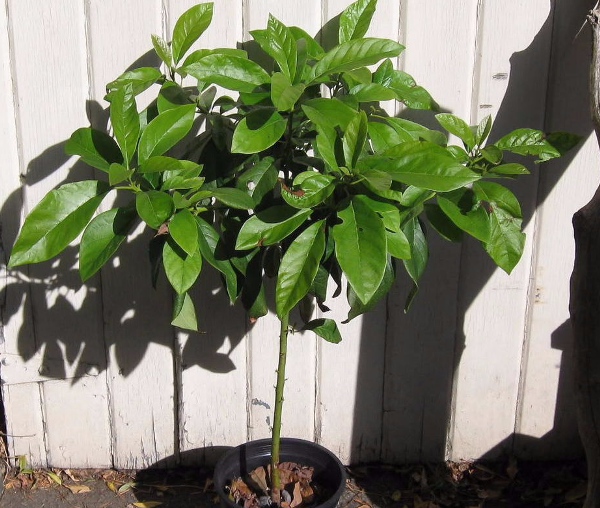
Flowers, and even more so fruits, are very difficult to achieve at home.
The narrow leaves of the tree have the shape of an ellipse of dark green color about 25 cm, and the flowers are collected in inflorescences.
The second name of this plant is “flamingo flower”.
Homeland beautiful flower is America and the Caribbean Islands, and the number of varieties reaches 1800. A feature of anthurium is glossy flower, which in its color and appearance resembles artificial plastic.
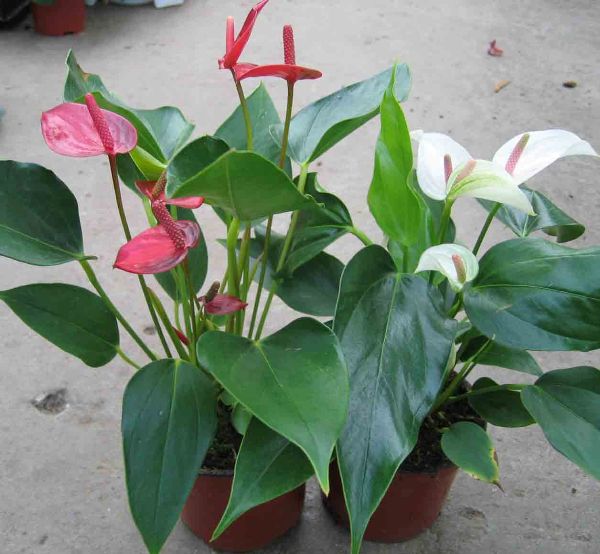
Anthurium, like all plants of the Araceae family, is poisonous. When consumed internally, it can cause irritation of the mucous membranes, and even swelling and breathing problems.
It can be painted in white and red colors. Problems often arise in caring for it.
Herbaceous plant from the Araceae family. Thanks to the large bright sheets that can reach 1 sq. meters, can also be called “elephant ear”.
Originally from Southeast Asia, which explains its love for warmth and high humidity. IN home environment grows up to 1.5 meters in height and lives on average 2 years.
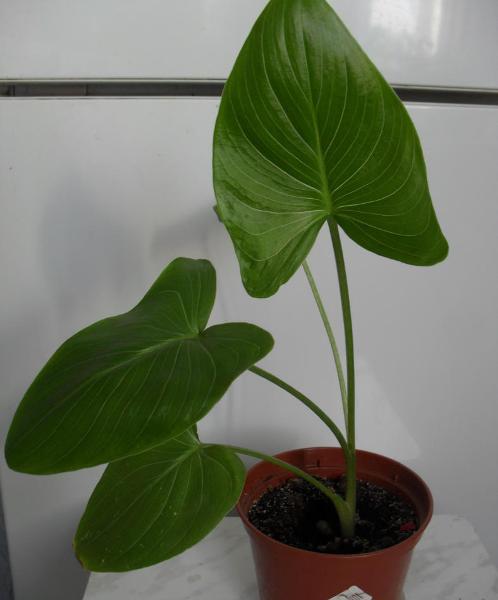
Blooms extremely rarely in the form of a white and pink cob. It is unpretentious in care, even novice gardeners can handle it.
Alocasia looks great in spacious rooms and freshens the air.
It earned its second name, “cast iron flower,” due to its durability.
Aspidistra can tolerate many conditions: infrequent watering, transplanting at the wrong time, sudden temperature changes, etc.
It is native to the regions of China and Japan and belongs to the Lily of the Valley family.
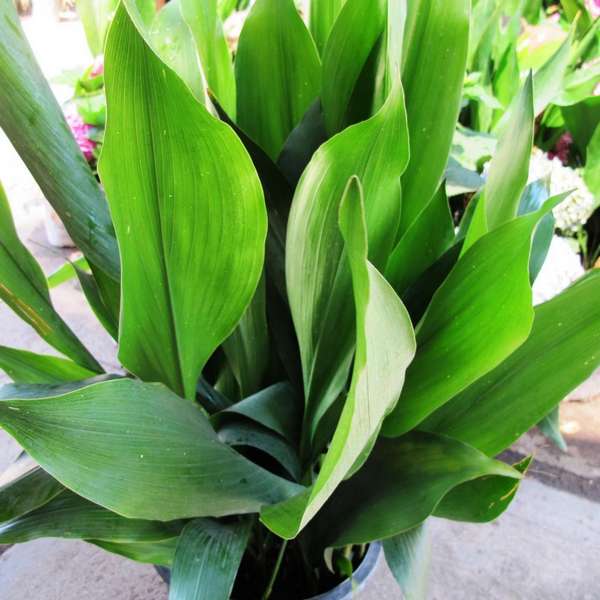
This plant has practically no stem, and the leaves have the shape of a long ellipse on the petioles. It rarely blooms, rather dirty - purple flowers at the base of the leaf. Due to the high chlorophyll content, it is perfect for dark rooms and stairs.
A plus is the ability to purify the air from benzene and formaldehyde.
This herbaceous plant is found in the territory of Brazil and Colombia. Easily adapted to life at home, where it grows quickly to a maximum height of 1.2 meters.
It does not require special care and lives quite a long time. Like all plants of the Araceae family - poisonous.
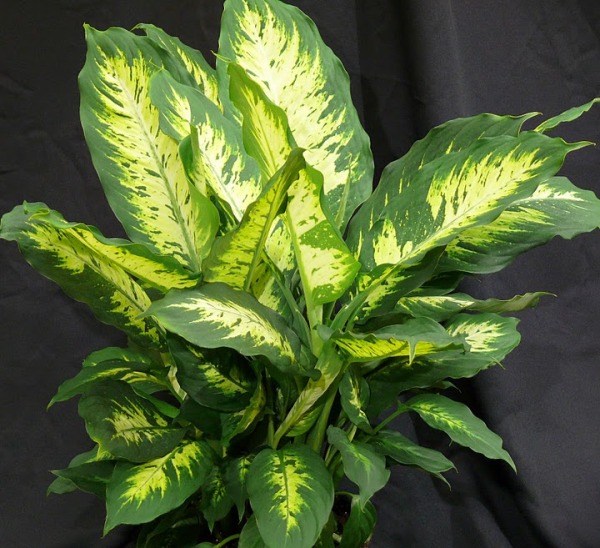
Due to its “decorative” appearance, the flower is very popular. Flower growers are attracted to the large, colorful, spotted leaves; the color varies depending on the species.
Considering the countries of origin, Dieffenbachia loves warmth and humidity. In such conditions, it can bloom with an inconspicuous inflorescence in the form of a white-green cob.
This low herbaceous plant originated from Central America. It belongs to the Marantaceae family, which has about 400 species.
Maranta's height is no more than 30 cm, due to predominantly creeping shoots. The peculiarity of this flower is its variegated, striped leaves with a smooth edge.
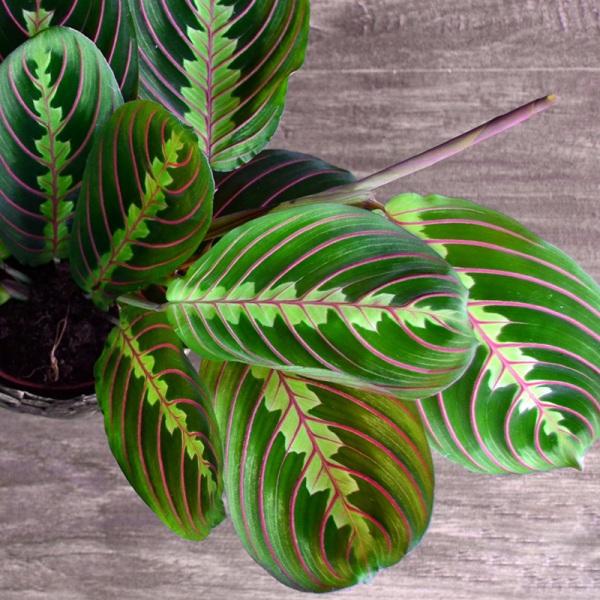
It blooms rarely with small spikelets of white or pale lilac flowers. White-veined arrowroot is unpretentious in care, but red-veined arrowroot requires more attention.
The leaves of the arrowroot family are folded at night.
One of the most famous large plants in our country originated from the tropics of Central America.
Belongs to the Araceae family and is a vine with large spreading leaves with slots. B feels good and grows up to 2.3 meters in height. Another feature of this vine is its aerial roots, which should be directed towards the ground.
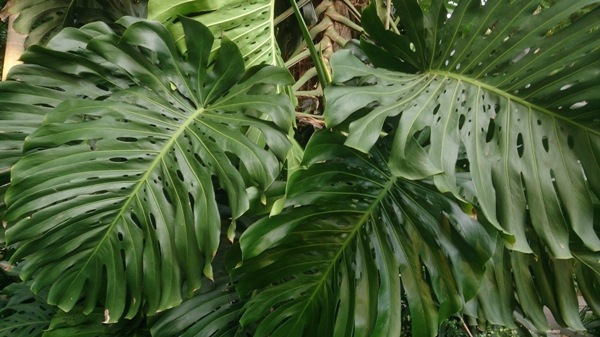
Monstera has unsightly flowers with pale green inflorescences, but practically does not bloom at home.
It got its name thanks to legends where monstera acts as a killer plant.
This is a liana of the Araceae family, native to Central and South America. Can reach a size of up to 1.5 meters. The stems are thin and flexible, topped with a leaf, shaped like an arrowhead.
Due to its ease of care, it is extremely common in our country. It can be found in houses and apartments, as well as in offices and various institutions.
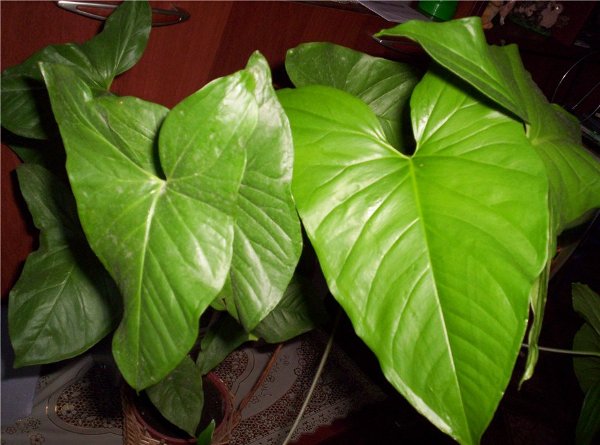
Capable of purifying the air from xylene and formaldehyde.
Like other Araceae, it practically does not bloom.
A herbaceous variegated plant of the Araliaceae family, it came to us from Asian countries. It is usually a shrub or small tree up to 1.4 meters in height.
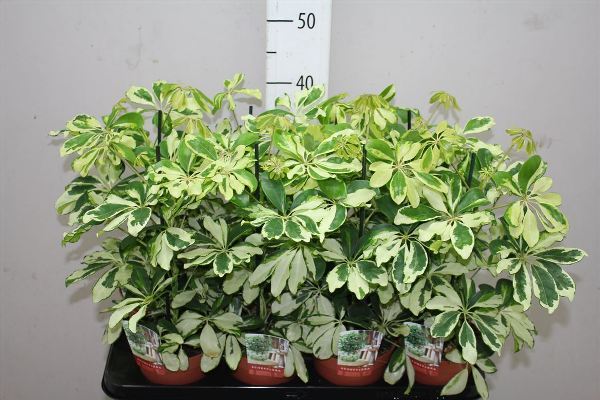
It is memorable due to its form. They resemble an open umbrella– several oval-shaped leaves (from 4 to 12), emerging from one center.
They can be plain or covered with light spots and stripes. It is easy to care for and lives quite a long time.
Toxic to children and animals.
Growing plants is not always associated with great difficulties. If you select unpretentious flower, you can diversify the room and refresh it with a large green “tree” without putting in much effort.









